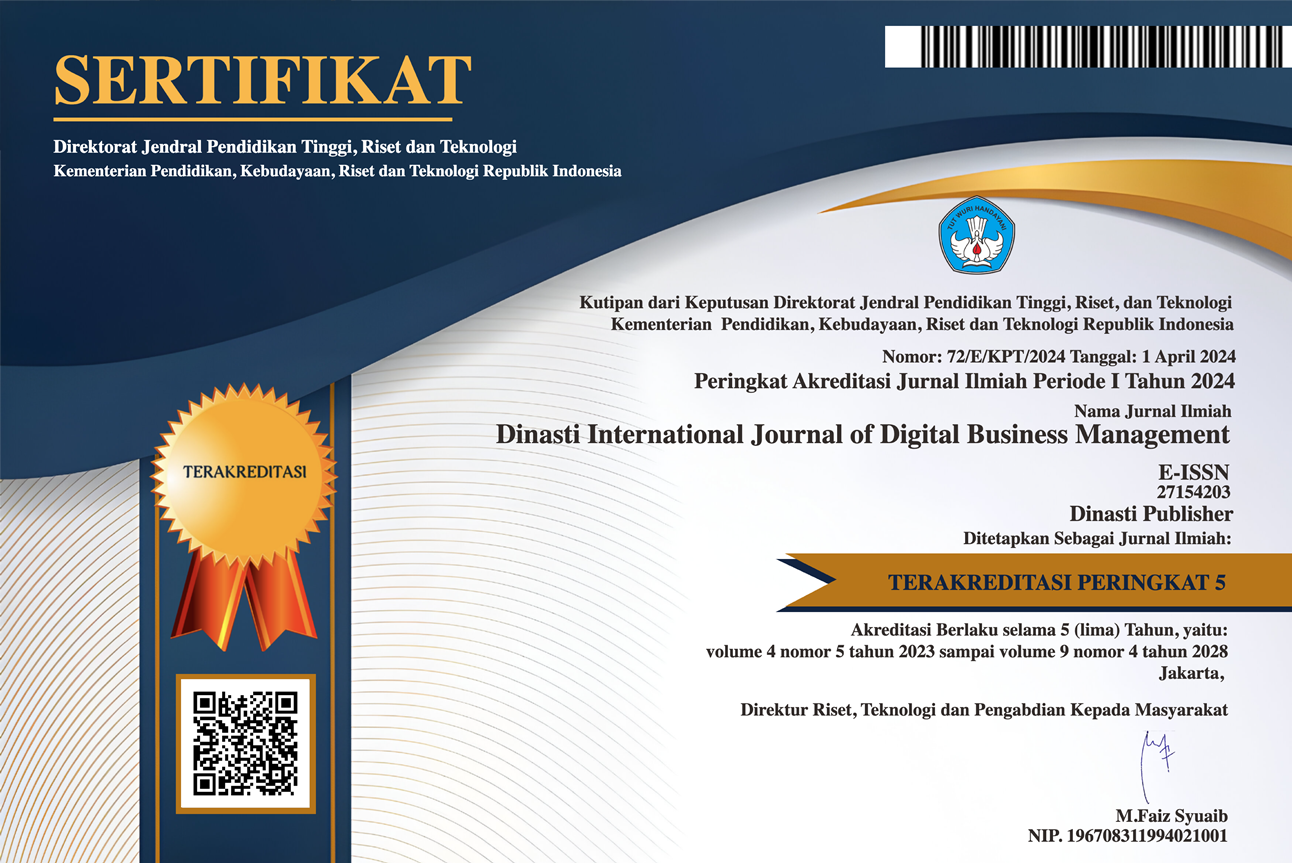Digital Transformation: Digital Maturity, Competitive Strategy, and Sustainable Business Model in Construction Industry. A Literature Review
DOI:
https://doi.org/10.38035/dijdbm.v6i1.3319Keywords:
Digital Transformation, Digital Transformation Strategy, Construction 4.0, Sustainability Business ModelAbstract
In this digital era, the use of digital technologies is a must to implement in any industry, including construction industry. There are many technologies that have been implemented by construction companies in their digital transformation agenda like BIM, Artificial Intelligence, IoT, Big Data & Analytics, 3D printing, etc. Prior to implement those digital technologies, construction company should develop a comprehensive and holistic digital transformation strategy. The purpose of this research is intended to give recommendations in defining the dimension of digital maturity assessment and aspects to be well-thought-out in creating digital strategy. Literature review methodology is applied with reviewing books and journals that discussed the digital maturity assessment and strategy development. In conclusion, the digital transformation strategy development is required the maturity assessment first to understand the current digital transformation. The digital transformation strategy is recommended to consider the impact to the surrounding environment in order to give the value not only for the construction company itself.
References
Ayton, D. (2023). Chapter 5: Qualitative descriptive research. Retrieved from Open Educational Resources Collective: https://oercollective.caul.edu.au/qualitative-research/chapter/__unknown__-5/#:~:text=A%20qualitative%20descriptive%20study%20is%20an%20effective%20design%20for%20research,analysis%20to%20be%20relatively%20simple.
Ayton, D. (2023). Chapter 5: Qualitative descriptive research. Retrieved from Open Educational Resources Collective: https://oercollective.caul.edu.au/qualitative-research/chapter/__unknown__-5/#:~:text=A%20qualitative%20descriptive%20study%20is%20an%20effective%20design%20for%20research,analysis%20to%20be%20relatively%20simple.
Badan Pusat Statistik. (2023). Indikator Konstruksi. Badan Pusat Statistik.
Badan Pusat Statistik. (2023). Konstruksi dalam Angka 2023. Badan Pusat Statistik.
Bisnis.com. (2024, May 25). Top 7 Bank Digital di Indonesia Kuartal I/2024: Seabank Teratas, Hibank Melesat. Retrieved from bisnis.com: https://finansial.bisnis.com/read/20240525/90/1768141/top-7-bank-digital-di-indonesia-kuartal-i2024-seabank-teratas-hibank-melesat
Bocken, N., S.W. , S., Rana, P., & Evans, S. (2014). A literature and practice review to develop sustainable business model archetypes. Journal of Cleaner Production, 42-56.
Broccardo, L., Zicari, A., Jabeen, F., & Bhatti, Z. A. (2023). How digitalization supports a sustainable business model: a literature review. Technological Forecasting and Social Change.
Casini, M. (2022). Construction 4.0: Advanced Technology, Tools and Materials for the Digital Transformation of the Construction Industry. Duxford: Elsevier.
Comin, L. C., Aguiar, C. C., Sehnem, S., Yusliza, M.-Y., Cazella, C. F., & Julkovski, D. J. (2020). Sustainable business models: a literature review. Benchmarking: An International Journal, 2028-2047.
De Mauro, A., Grimaldi, M., & Greco, M. (2014). What is Big Data? A Consensual Definition and a Review of Key Research Topics. 4th International Conference on Integrated Information.
detikcom. (2017, Agustus 22). Awal Mula Transportasi Online Menjamur di Indonesia. Retrieved from detikcom: https://inet.detik.com/cyberlife/d-3609781/awal-mula-transportasi-online-menjamur-di-indonesia
Hanelt, A., Bohnsack, R., Marz, D., & Marante, C. A. (2021). A Systematic Review of the Literature on Digital Transformation: Insights and Implications for Strategy and Organizational Change. Journal of Management Studies, 1160-1197.
Hendricks, D. (2024, April 25). How to Create a Sustainable Business Model. Retrieved from business.com: https://www.business.com/articles/how-to-create-a-sustainable-business-model/
Hillebrandt, P. M. (2000). Economic Theory and the Construction Industry. London: MACMILLAN PRESS LTD.
Hongwei, Z., Liang, W., Chao, L., Simon, P. P., Hujun Li, Hui, L., & Martin, S. (2023). Building a Digital Transformation Maturity Evaluation Model for Construction Enterprises Based on the Analytic Hierarchy Process and Decision-Making Trial and Evaluation Laboratory Method. MDPI-Buildings, 1-20.
Isystain. (2020, May 19). Why stakeholder management is essential to sustainable business. Retrieved from isystain.com: https://www.isystain.com/blog/2020/5/18/stakeholder#:~:text=For%20a%20company%2C%20this%20typically,suppliers%2C%20customers%20and%20employees.%E2%80%9D
Jonas Construction Software. (2023, Juli 17). The 5 Phases of Construction Project Management & How Software Can Help. Retrieved from jonasconstruction.com: https://www.jonasconstruction.com/blog/phases-of-construction-project-management/#:~:text=This%20process%20can%20be%20broken,construction%2C%20and%20post%2Dconstruction.
Kementerian Koordinator Bidang Perekonomian Republik Indonesia. (2018, April 4). Pemerintah Luncurkan Making Indonesia 4.0. Retrieved from ekon.go.id: https://ekon.go.id/publikasi/detail/1443/pemerintah-luncurkan-making-indonesia-40
Kementerian Perindustrian Republik Indonesia. (2018). Indonesia Industry 4.0 Readiness Index (Indeks Kesiapan Industri di Indonesia untuk Bertransformasi Menuju Industri 4.0). Jakarta: Kementerian Perindustrian Republik Indonesia.
Leong, L. K., Manickam, L., Haque, R., Jumbulingam, K., & Md Noordin, N. B. (2024). Embracing Digital Transformation for Sustainable Business in the Construction Industry. Pakistan Journal of Life and Social Sciences, 1621-1640.
McKinsey Global Institute. (2011). Big Data: The next frontier for innovation, competition, and productivity. McKinsey Global Institute.
Orpha, J. (2022). Strategic Management +. Bandung: Refika Aditama.
Polman, P., & Winston, A. (2021). Net Positive. How Courageous Companies Thrive by Giving More Than They Take. Boston: Harvard Business Review.
Porter, M. E. (1996). What is strategy? Harvard Business Review, 37-55.
Remane, G., Hanelt, A., Wiesböck, F., & Kolbe, L. (2017). DIGITAL MATURITY IN TRADITIONAL INDUSTRIES – AN EXPLORATORY ANALYSIS. Twenty-Fifth European Conference on Information Systems (ECIS).
Scheneider Electric. (2022, May 16). Sustainable business model innovation: A brief overview. Retrieved from Scheneider Electric: https://blog.se.com/sustainability/2022/05/16/sustainable-business-model-innovation-a-brief-overview/#:~:text=Assuring%20resource%20efficiency%2C%20ethical%20business,a%20successful%20sustainable%20business%20model.
Tempo. (2015, Oktober 26). Ojek Pangkalan Geruduk Kantor Gojek di Bandung . Retrieved from tempo.co: https://nasional.tempo.co/read/713181/ojek-pangkalan-geruduk-kantor-gojek-di-bandung
Thompson, Jr., A. A., Peteraf, M. A., & Gamble, J. E. (2017). Essentials of Strategic Management. The Quest for Competitive Advantage. New York: Mc Graw Hill Education.
Downloads
Published
Issue
Section
License
Copyright (c) 2025 Wildan Gilang, Orpha Jane

This work is licensed under a Creative Commons Attribution 4.0 International License.
Authors who publish their manuscripts in this journal agree to the following conditions:
- The copyright on each article belongs to the author(s).
- The author acknowledges that the Dinasti International Journal of Digital Business Management (DIJDBM) has the right to be the first to publish with a Creative Commons Attribution 4.0 International license (Attribution 4.0 International (CC BY 4.0).
- Authors can submit articles separately, arrange for the non-exclusive distribution of manuscripts that have been published in this journal into other versions (e.g., sent to the author's institutional repository, publication into books, etc.), by acknowledging that the manuscript has been published for the first time in the Dinasti International Journal of Digital Business Management (DIJDBM).















































